Dulce de Leche (Cooked Condensed Milk)
An easy Dulce de Leche (Cooked Condensed milk) recipe with only 1 ingredient! Sweetened condensed milk is cooked until it becomes thick, creamy caramel-like pudding that you can use for many dessert recipes. It’s delicious straight out of the can, with ice cream, in coffee or spread onto apple slices.
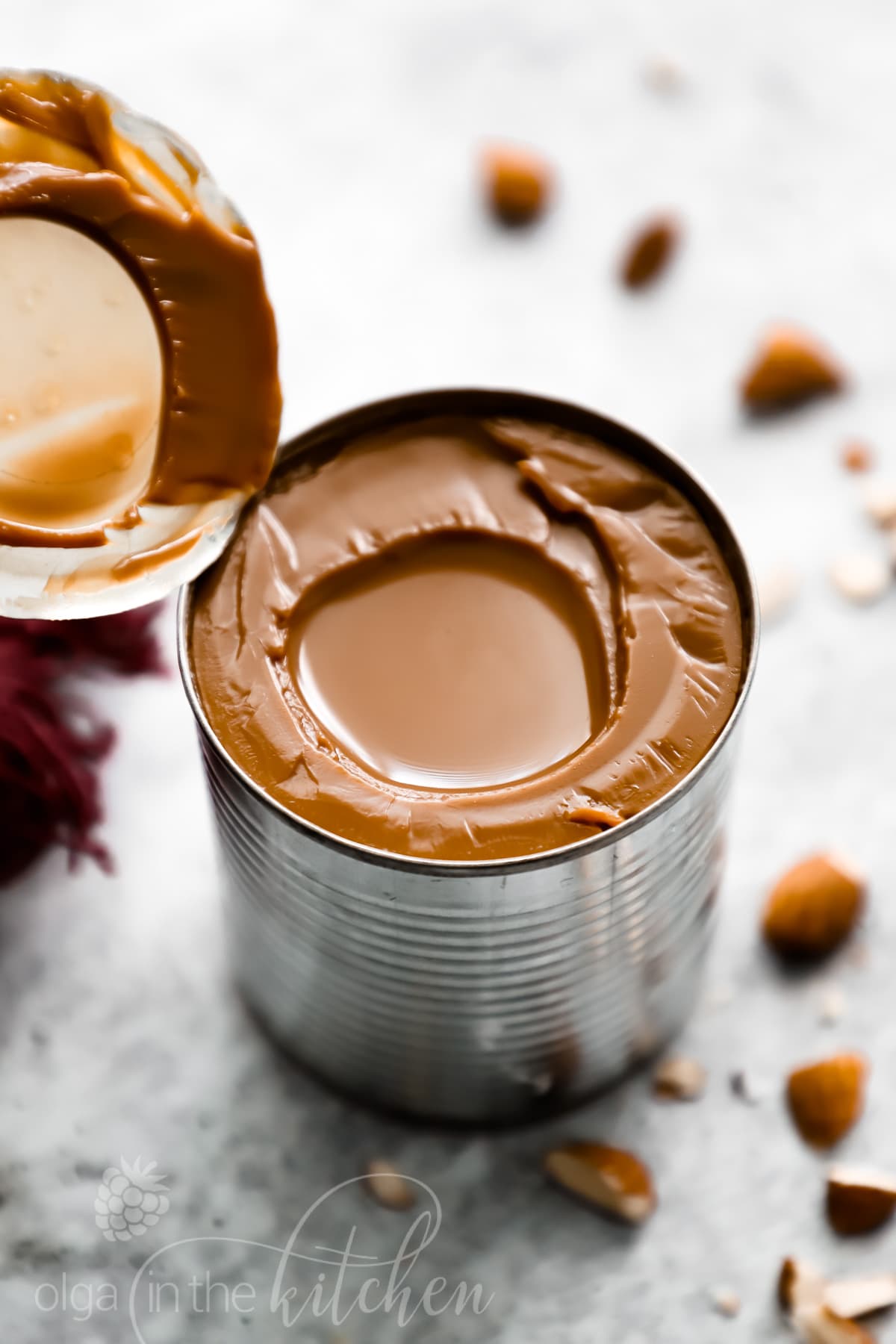
This post may contain affiliate links. Read my disclosure policy.
Dulce de Leche (Cooked Condensed Milk) Recipe:
Cooking sweetened condensed milk is almost like a tradition among Ukrainian families, except we always called it sguschonka. We use it for cookies and cakes and that’s why we need the thickest texture possible to create thick fillings and frostings for desserts. Using this method of cooking sweetened condensed milk, you get the best results with minimal attention.
You might notice on the back of the can, it says ‘never heat in unopened can’. This is basic knowledge, meaning you don’t want to stick the can into microwave, oven or stove. Just as you would not heat any other canned soups or sauces in cans. Make sure cans are fully submerged in water at all times while cooking.
I like to boil 4-5 cans at a time so I always have some on hand. For last minute baking or when we feel like eating dessert, we make the Waffle Cake. It’s the most delicious, quickest dulce de leche dessert you will ever have!
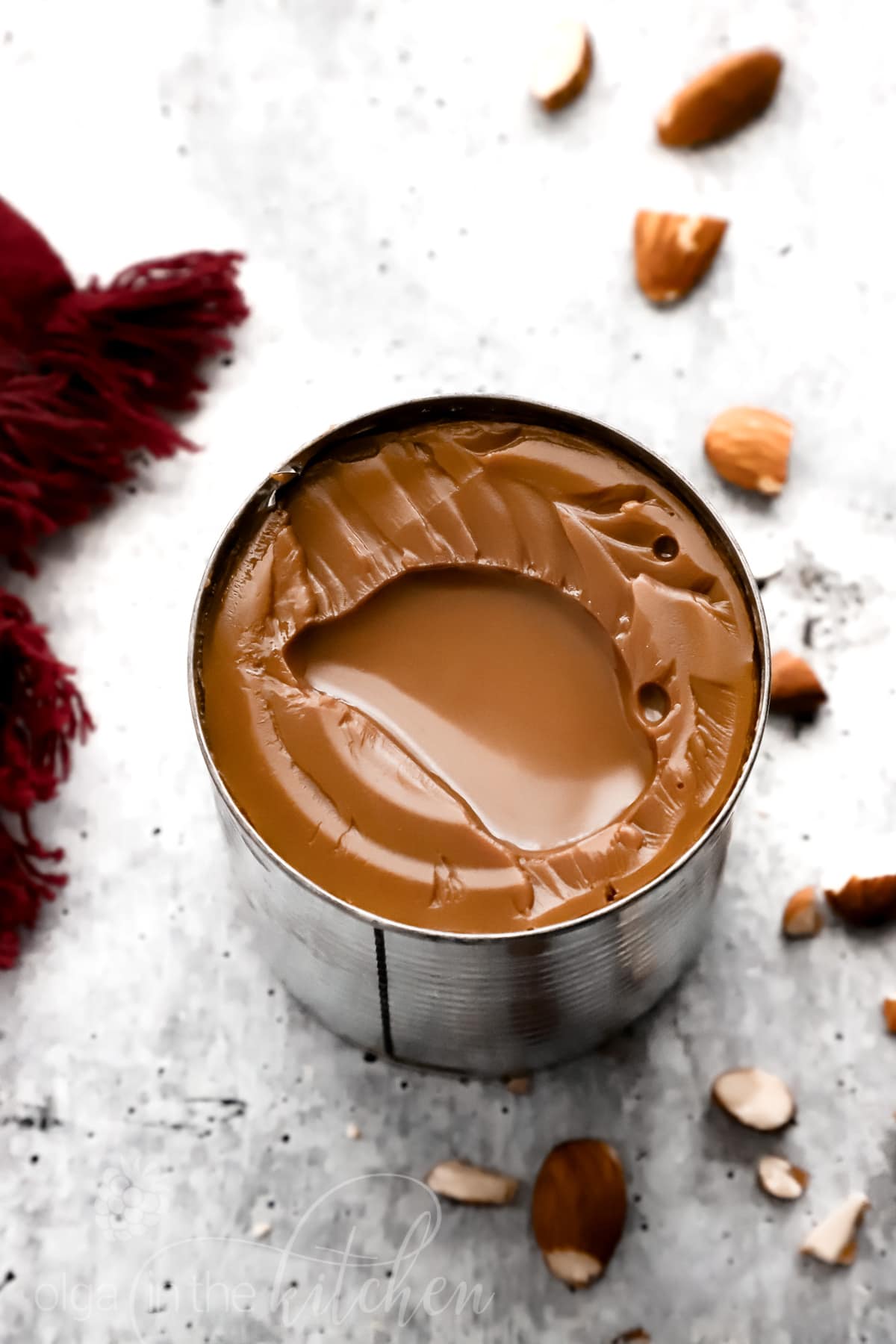
What is Dulce de Leche?
Dulce de leche (cooked condensed milk) is a thickened caramel-like sauce that’s made out of milk and sugar. In other words, it’s sweetened condensed milk heated until it thickens and caramelizes. It’s thick and gooey confection, with a nutty brown color and a taste that’s not quite like anything else. You can also call it jam that’s made out of sweetened condensed milk.
It’s creamy, sweet and caramelized and can range in consistency from a chewy candy to a soft sauce, depends on your desired consistency and color. Very similar to caramel sauce, but so much easier to make especially if you’re using store-bought sweetened condensed milk.
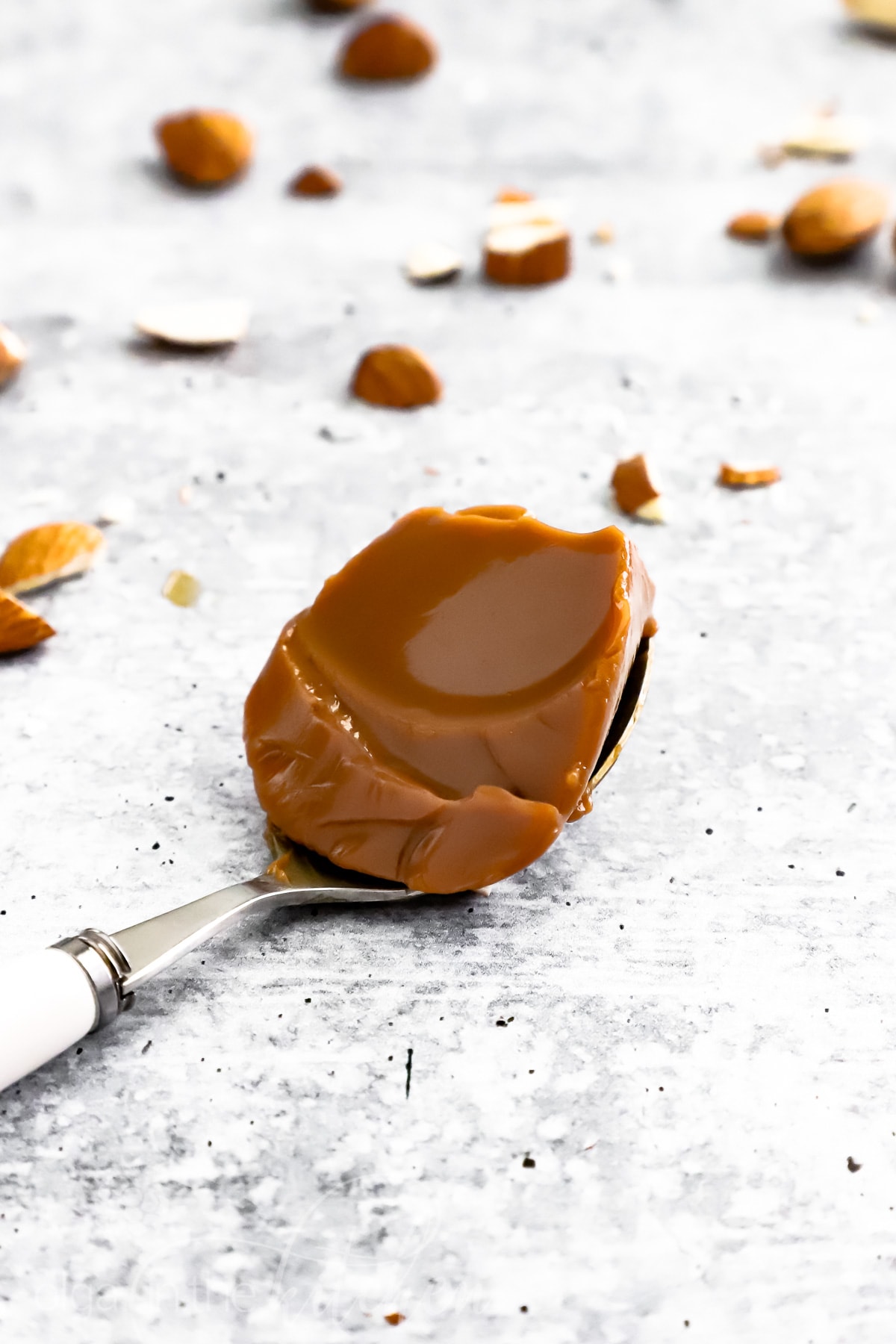
Dulce de Leche Ingredients:
This quick tutorial requires only 1 ingredient since water does not really count as an ingredient. We like to use our favorite brand Nestle La Lechera, but you can use any of your favorite brands in here. You can do as much as 5 cans in a pot in single row, or as little as 1 can. Use room temperature water to fully cover the cans making sure they are always fully submerged in water.
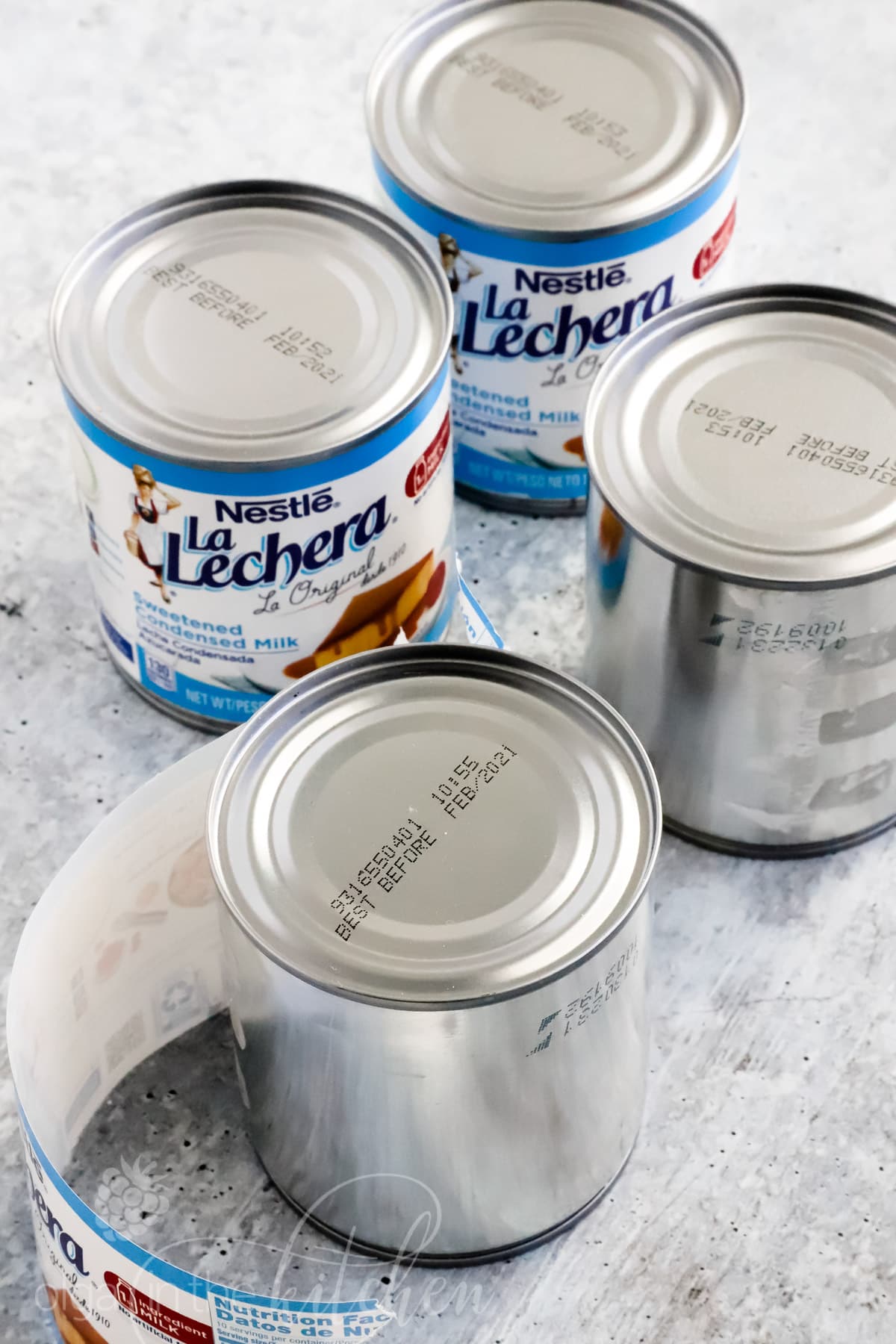
How to Make Dulce de Leche From Condensed Milk?
- Remove the labels off the cans.
- Place cans of sweetened condensed milk into a big pot right-side up. You need a pot with lid.
- Cover cans with room temperature water, making sure the water level is at least 2-inches above the cans.
- Bring the water to a very light rolling boil over medium-high heat. Reduce heat to lowest and let simmer for 3 to 3 1/2 hours for thickest texture, making sure cans are fully submerged in water at all times.
- Once cans have simmered to desired cooking time, remove the pot from the heat and leave the cans in the water to cool to room temperature. This will ensure the thickest dulce de leche texture possible.
- If not using right away, refrigerate once cooled for up to 1 month in unopened cans.
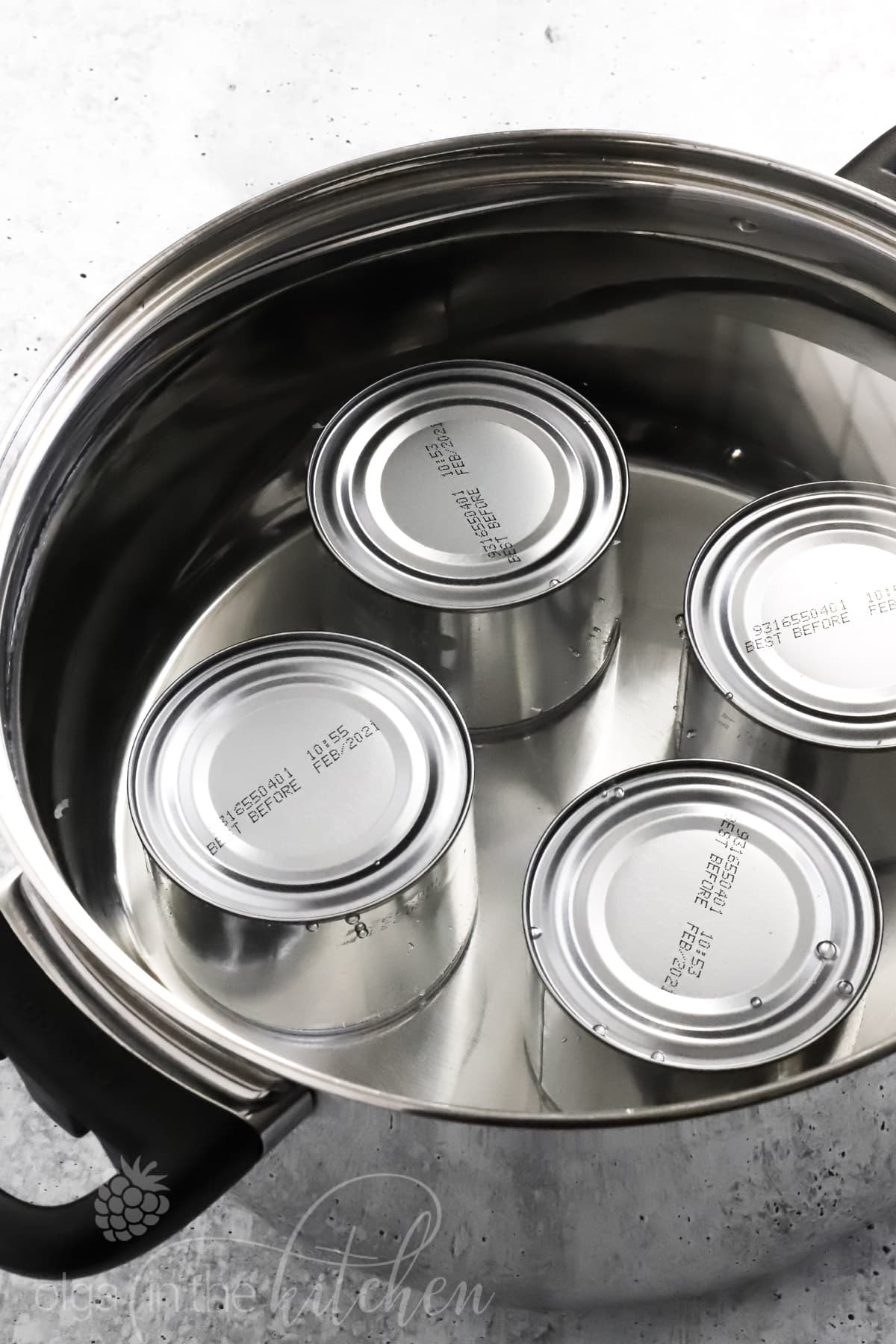
How Long Should I Cook the Condensed Milk?
The cook time will depend on how thick and dark you want the dulce de leche to be.
- 2-hours cook time will result in a lighter caramel (golden creamy dulce de leche with a thinner texture).
- 3 to 3 1/2-hours cook time will result in a dark brown rich color with thickest texture possible.
How to Store Dulce de Leche?
Let dulce de leche cool to room temperature in cans. Without opening the cans, store them in the refrigerator for up to 1 month. From experience, a month was the longest I kept it without it sugaring.
If you opened a can and want to store leftovers, transfer to an airtight container or glass jar. Never store opened dulce de leche in a can!
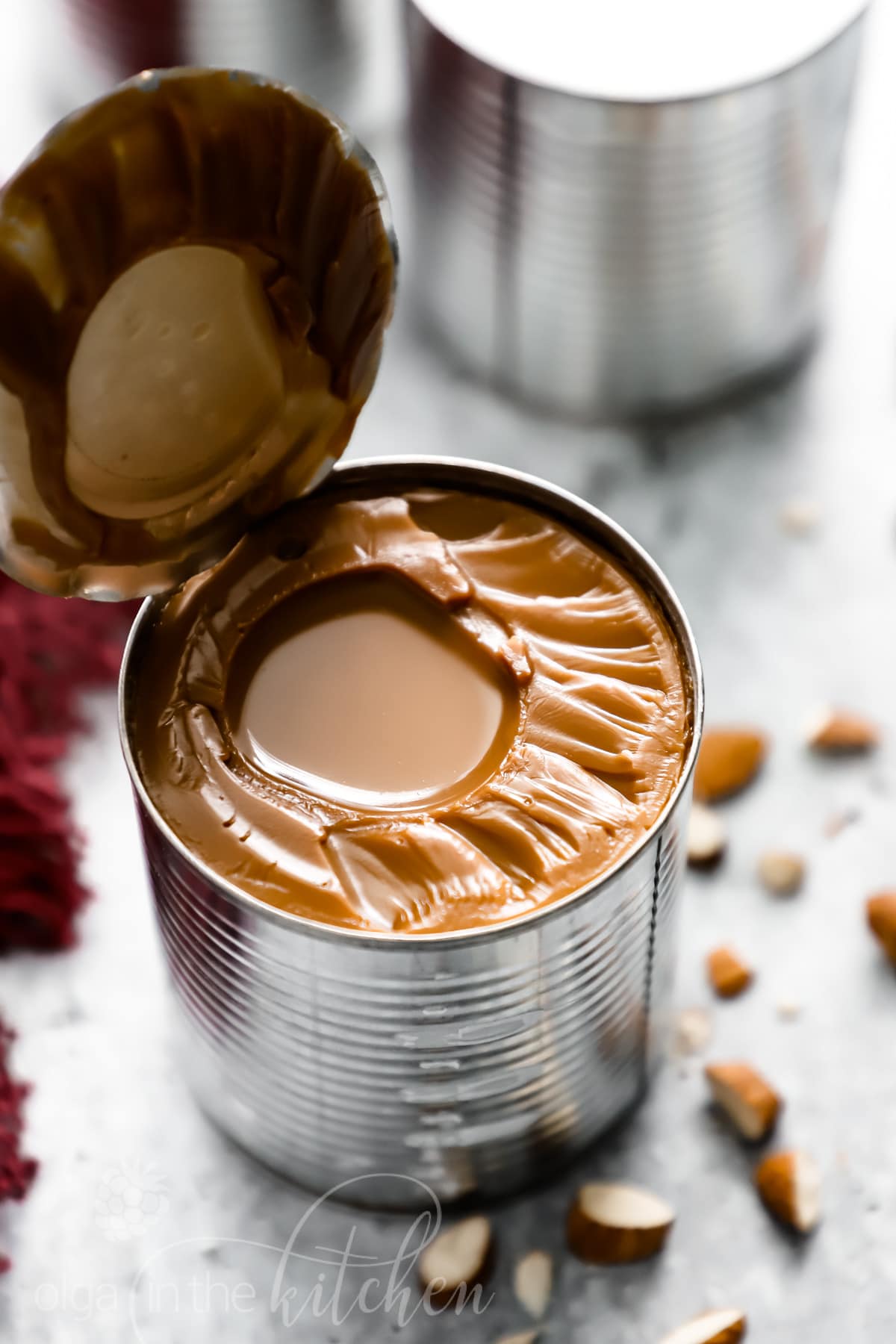
Is Dulce de Leche Caramel?
The key difference between dulce de leche and caramel is that dulce de leche is made from condensed milk (milk and sugar), while caramel is made from sugar and water.
Dulce de leche is usually made by heating up condensed milk and it contains higher sugar levels than regular milk. Once it’s heated, the sugar browns creating golden brown color. Caramel is made by heating sugar until it’s brown in color and sometimes milk and butter are added to create caramel sauce.
Ways to Enjoy Dulce de Leche:
Eating it by spoonful is probably the most common way to enjoy dulce de leche, but not in my family. We make dulce de leche to use in fillings for desserts or to make cake frosting combined with cream cheese and/or heavy cream. The thicker the dulce de leche, the better results and easier it is to work with when it comes to Ukrainian desserts. Here are some other fun ways to enjoy dulce de leche:
- As a sweetener in coffee or hot chocolate (dulce de leche + milk)
- Drizzle on crepes, ice cream or brownies
- For sticking cookies together
- Dulce de leche apples – just like caramel apples
- Spread onto graham crackers or plain biscuits
- As a dip or spread for churros or apple slices
- Cheesecake or as caramel layer between cake slices
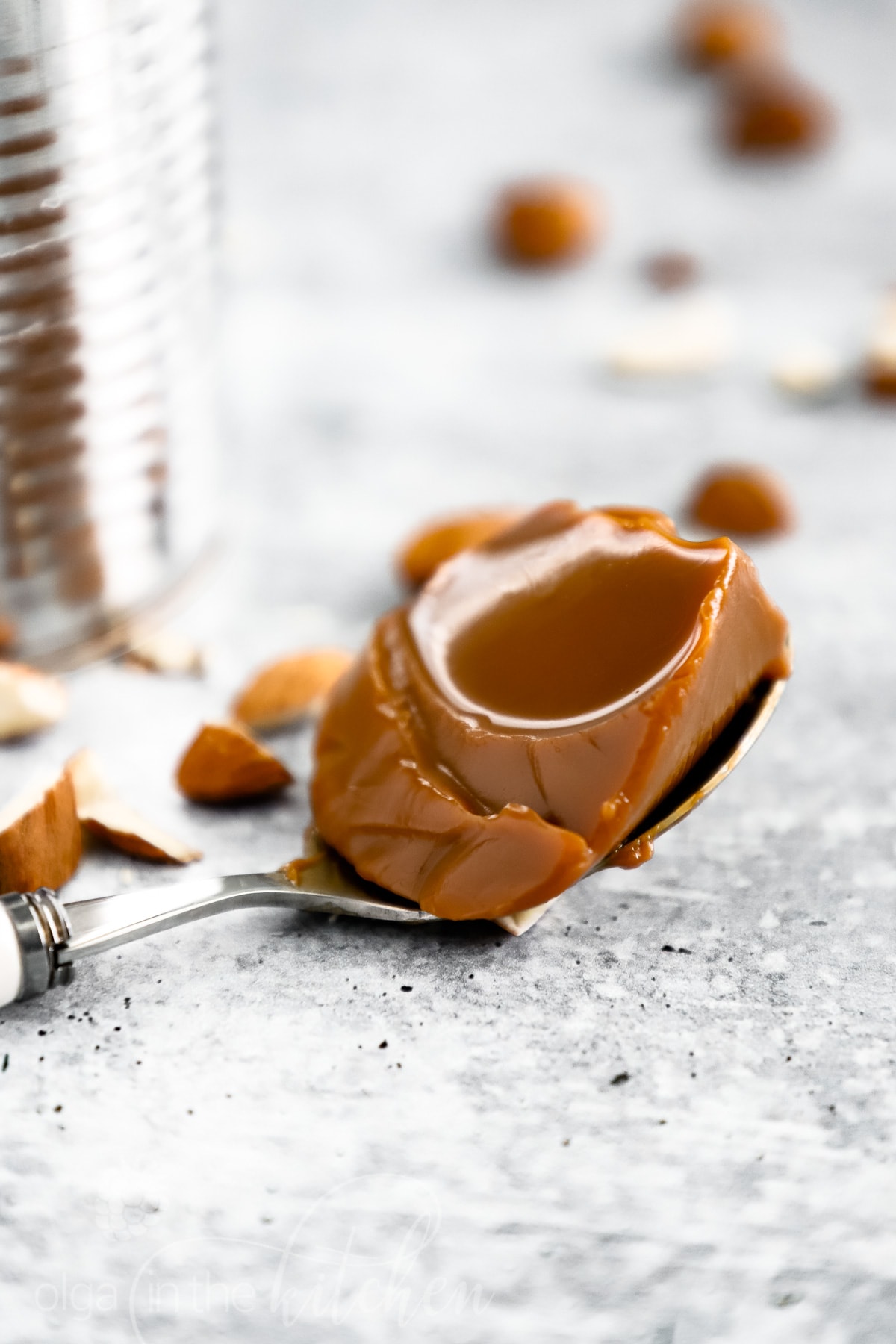
Tips for Making Dulce de Leche:
- Use stainless steel pot for best results and better control of heat and water.
- Cover pot with lid to keep water from evaporating.
- Reduce heat to low as soon as pot with cans starts boiling.
- Pay attention to the water level. Make sure cans are submerged in water at all times. Not enough water can lead to cans overheating, tearing or even popping. (For decades using this method, we never had it happen).
- Do not try to open cans while still hot as the hot dulce de leche may spit out because of the pressure inside.
- Refrigerate cooled cans of dulce de leche unopened for better storage lifetime and to prevent sugaring. Never refrigerate opened dulce de leche in cans. Transfer leftovers into airtight container or glass jar.
Best Brand of Sweetened Condensed Milk:
Our all-time favorite is the Nestle La Lechera brand. My husband and kids love to spread sweetened condensed milk over a freshly baked slice of bread or our Bread Machine White Bread.
La Lechera Sweetened Condensed Milk has the best taste before it even turns into dulce de leche. Therefore, I always have at least 2 cans on hand. You will get same results from Eagle Brand and genetic store brands should work just as fine.
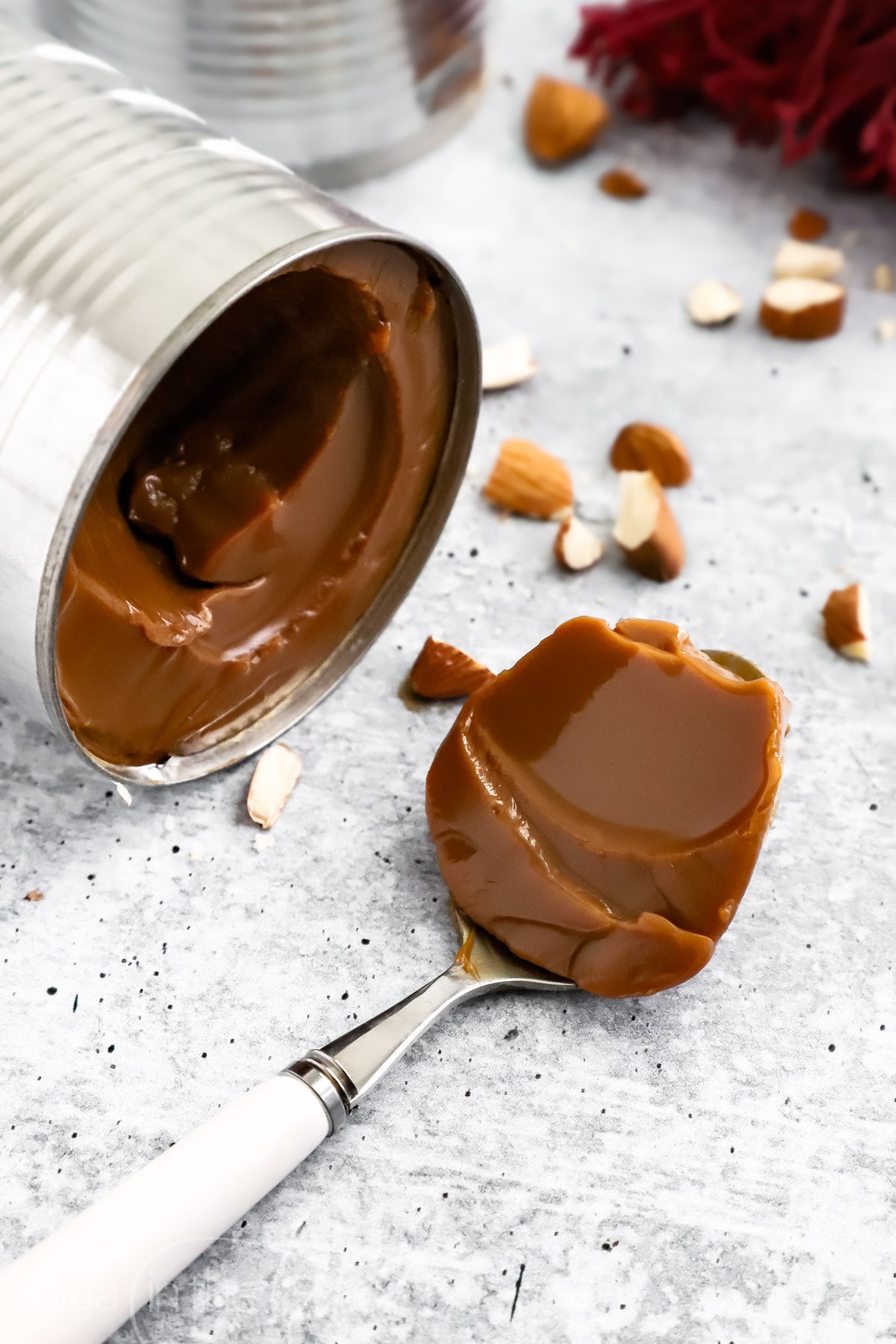
Where to Buy Dulce de Leche?
Nowadays, you can find dulce de leche in any grocery store or supermarkets. In my whole lifetime, I purchased store-bought dulce de leche maybe 3 times. I have to be honest; it is not the same as homemade. It’s called dulce de leche, but at the same time has some hidden additions in it that makes it taste like dulce de leche with something extra. Homemade is thousand times better!
Our All-Time Favorite Dulce de Leche Cookies:
We love dulce de leche desserts! I won’t be wrong if I say we have at least one variety of them at every gathering. We especially like dulce de leche cookies; the filling is irresistible!
- Oreshki Recipe (Walnut Shaped Cookies) – yummy dulce de leche filling
- Peach Cookies with Dulce de Leche Filling (persiki) – elegant and fun, no appliance needed
- Ukrainian Dulce de Leche Waffle Cake – easiest dessert; we call them cookies once they are cut into smaller pieces
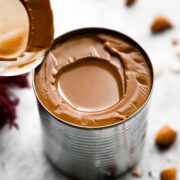
Dulce de Leche (Cooked Condensed Milk)
Ingredients
- 4 cans sweetened condensed milk
- water - room temperature
Instructions
- Remove the labels off the cans.
- Place 4 cans of sweetened condensed milk into a big pot right-side up. You need a pot with lid.
- Cover cans with room temperature water, making sure the water level is at least 2-inches above the cans.
- Bring the water to a very light rolling boil over medium-high heat. Reduce heat to lowest and let simmer for 3 to 3 1/2 hours for thickest texture, making sure cans are fully submerged in water at all times. Add more hot water if needed in case some water evaporates during the simmering process. With lid on, you shouldn’t have to do it.
- Once cans have simmered to desired cooking time, remove the pot from the heat and leave the cans in the water to cool to room temperature. This will ensure the thickest dulce de leche texture possible. For slightly thinner or lighter in color dulce de leche, remove cans from the hot water using a pair of kitchen tongs and allow them to cool to room temperature. Giving time to cool, will let dulce de leche firm up. Do not try to open cans while still hot as the hot dulce de leche may spit out because of the pressure inside.
- If not using right away, refrigerate once cooled for up to 1 month in unopened cans.
Notes
- Store: Cool dulce de leche to room temperature. Without opening the cans, store them in the refrigerator for up to 1 month. Store opened can leftovers in an airtight container or glass jar in refrigerator. Never store opened dulce de leche in a can!
- Ways to Enjoy Dulce de Leche: Eating spoonful. Use in desserts as filling or in frosting (Oreshki or Peach Cookies). As a sweetener in coffee or hot chocolate (dulce de leche + milk). Drizzle on crepes, ice cream or brownies. Spread onto graham crackers or plain biscuits. As a dip or spread for churros or apple slices. Cheesecake or as caramel layer between cake slices.
- Cook Time: 2-hours for lighter caramel (golden creamy dulce de leche with a thinner texture). 3 to 3 1/2-hours cook for dark brown rich color with thickest texture possible.
- Pot and Lid: For best results, use an old stainless steel pot with lid for better control of heat and water. Cover pot with lid to keep water form evaporating.
- Pot-Cleaning: Pot will get a bit sticky from the glue on cans, but it's very easy to clean. I use Bar Keepers Friend or baking soda and a scrubbing pad to turn the pot into new again.
We first published this recipe in July 2017 and updated it in May 2020 with new photos and more tips.

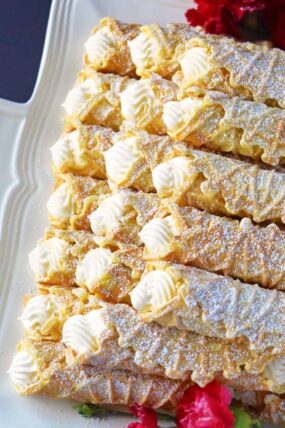
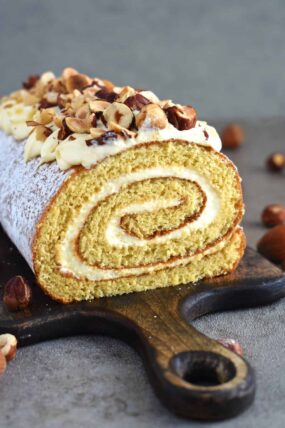

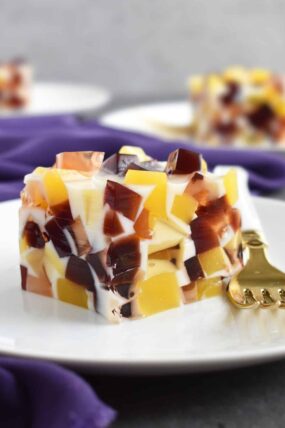
Nancy says:
I’m currently simmering the sweetened condensed milk. It has been on for about 45 minutes and the tops of the lids, at the seam, are discoloring. It looks like rust, is this normal?
Olga in the Kitchen says:
I’ve never paid attention while it’s simmering, but I know for a fact it does have rust around the rim when completely cooked and when slightly cooled. Also, depends on the age of cans. Some cans can turn out completely clean, while others very rusty and I always use the same brand. I’ve cooked 5 recently bought cans for myself yesterday and I can see they have rust around the rims on each can. As long as it’s rust, it’s good. Just make sure to keep it on low so it doesn’t boil too much and at least 1″ water over the cans. I always keep the lid on, this will keep the water from evaporating and decreasing. When cans are cooled, before opening the cans, always make sure you wipe around with a wet paper towel to remove the rust and avoid it in dulce de leche.
Vani says:
Hi there, I have been using this method forever, learned it from my mom. Lately I have been wondering if there could be any unhealthy side effects from heating the tin that might leak into the dulce? Im wondering if one could put the condensed milk in a glass container, like an old mermelade container and cook it that way?
Olga in the Kitchen says:
Without experimenting myself, I wouldn’t know how or the results cooking it in glass container. My family have used this method for many decades and I honestly never noticed anything unusual in the cooked condensed milk (and I’m very observant when it comes to food 🙂 ). You would see bubbles of water or discolored liquid inside the can if it would have been leaking. But keep in mind, that all the food sold in the stores in cans comes without air with years forward in expiration date, so the cans of condensed milk are sealed just like any other can you purchase from store, making sure nothing gets inside (water in this case). Boiling cans in water that aren’t bent, always a success and gives best results in texture. Hope this helps 🙂
Zorayda says:
Thank you so much! My mother made this all the time when I was little but we couldn’t remember how long she boiled it. However, she did eventually use a pressure cooker. Have you tried cooking it that way and how long would you leave it in the pressure cooker?
BTW – I am Hispanic but I’m surprised this is also Ukranian! Wonderful discovery!!
Olga in the Kitchen says:
I think this boiling method goes way back around countries, not sure where it was originated officially. As for the pressure cooker, I have not tried it. Without experimenting myself, I wouldn’t know how. If you do decide to try, please share with us 🙂
Maureen Brunn says:
I’m 73 and our mother would always make dulce de leche for we 5 children, she was an amazing cook but it took till we grew up to appreciate just how good she was. Making it now brings back soon many beautiful memories and unfortunately Kgs.
Olga in the Kitchen says:
Thank you for sharing that with us, Maureen! I’m happy to hear you enjoyed this recipe!
Jennifer says:
Hi thanks for the recipe. How thin or thick does this get? Does it solidify? Can you pour over the top of a Bundt cake and remain creamy(without either seeping into cake or turning into a stiff hard mess.)? And do you have to refrigerate when used as filling or topping if made the night before?
Olga in the Kitchen says:
Hi Jennifer! Without experimenting myself, I wouldn’t know the outcome if you were to pour over bundt cake. We use dulce de leche as a filling for cookies or an ingredient for frostings. If you follow the recipe and cook it for recommended time, the dulce de leche turns out pretty thick so you won’t be able to pour it, but you would want to spread with knife or spatula. When we use dulce de leche in cookies, we keep the cookies at room temperature in order for them to get moist. If you spread it onto a cake, you probably should refrigerate it so it doesn’t thin out at room temperature. BUT, like I said, without trying it myself, I wouldn’t know for sure. Hope this helps!
Lola stad says:
Opened a can of condensed milk was color of mideum brown.is this still good to use??or should I discard it.???
Olga in the Kitchen says:
Make sure that you are using uncooked condensed milk and not already cooked. Keep in mind that different brands have different uncooked condensed milk color, some off white color, others even darker. However, as the product ages it may darken in color and thicken. As long as the ‘best if used by’ date is still current, the product can still be used to cook and turned into dulce de leche. The change in color or texture should not affect recipe results. Just to clarify, cans should not be opened before cooking. For the very best results, use fresh (recently bought from store) cans. Aged cans can also start getting sugary on the bottom of cans.
Joanne says:
I’ve made dulce de leche a few times using the oven method. It was OK, but not very smooth. And not thick enough. So I tried this one, and it turned out perfectly! With the lid on, I didn’t even have to add water and I boiled it for 3 1/2 hours. Very smooth, very thick, and very delicious. And it was super easy – I kept an eye on it but didn’t have to do anything the entire time. This is the recipe I’m using from now on. Thank you so much for the recipe and detailed instructions. You made this so easy and a real success for me. 🙂
Olga in the Kitchen says:
Thank you for the wonderful review, Joanne! And thank you for sharing that with us. I’m so happy to hear you enjoyed this easy tutorial. 🙂
Maribel says:
I’m surprised to see this is done in Ukraine. Its really common in South America and is called manjar or dulce de Leche. I had some Chileans show me this exact recipe. It’s very common in Chile.
I’ve had it so often but never actually done it myself
Olga in the Kitchen says:
My grandma had been making it this way, then my mom and now me. I don’t know exactly for how long, but at least for four decades and this method was just passed along. The only method we make dulce de Leche. 🙂
Katerina says:
Fantastic recipe! I made 5 cans of these using your method for Christmas to fill my peach and oreshki cookies. The texture was so thick, you would not get it from other methods of making dulce de leche. Made the filling desserts so much easier. From now on, this is the only way I’m making my dulce de leche.
Olga in the Kitchen says:
Thank you for sharing that with us, Katerina! I’m so happy to hear you enjoyed this recipe! 🙂
Karen says:
I followed the directions exactly and it was thick when opened the can. When I put it in my Banoffee Pie and refrigerated overnight and fixed my pie the next day , the caramel began to weep and get very loose. Dont know what I did wrong Any ideas?
Olga in the Kitchen says:
Hi Karen! Just to clarify, this post is ONLY for Dulce de Leche, not for Banofee Pie (which I don’t even have on my website). This wouldn’t be a dulce de leche issue because like you mentioned, the dulce de leche was thick so the recipe did indeed work perfectly for you because it’s suppose to be thick if you follow the recipe. You would troubleshoot the pie recipe on the recipe website of author you used the pie recipe from. Dulce de leche is thick and stays thick refrigerated or at room temperature all the time, UNLESS you start adding things to it then the texture changes. I have never made a Banoffee Pie, but I did a bit troubleshooting for you in case you don’t get an answer from the owner of the pie recipe. I see bananas are used for that pie and people saying that bananas have a tendency to weep, making the custards (in this case the dulce de leche) into a soupy mess. It’s recommended to refrigerate the pie overnight between putting the dulce de leche in and the bananas so that the dulce de leche sets firmly. The less time bananas have on dulce de leche the better. Hope this helps and I would recommend you write about this issue on the whatever recipe site you did! 🙂
Jennifer says:
Hi! Can it be used in a dessert to freeze as well? Will it thaw and be a thick consistency still?
Olga in the Kitchen says:
Hi Jennifer! I don’t have experience with freezing filled desserts. Just never had that need to do it, therefore I cannot say how it will turn out. The only dessert with filling I freeze are the macarons that I know work. Sorry I couldn’t help much. If you do decided to try it out, please do share with us. Thanks 🙂